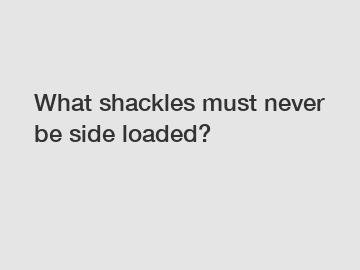What shackles must never be side loaded?
When it comes to lifting heavy loads, safety should always be the top priority. One crucial aspect of safe lifting is ensuring that the equipment being used is properly loaded. Side loading, or applying a load perpendicular to the intended direction of force, can significantly weaken the equipment and increase the risk of failure. In the case of shackles, certain types must never be side loaded to prevent accidents and injuries.
Shackles are widely used in lifting and rigging operations to connect various components and secure loads. They come in different shapes and sizes, but the most common types are anchor shackles and chain shackles. While shackles are designed to withstand high levels of vertical forces, they are not meant to bear loads from the side. Side loading can cause the shackle to bend or break, leading to catastrophic failures.
One type of shackle that should never be side loaded is the screw pin shackle. These shackles have a threaded pin that screws into the shackle body to secure the load. While screw pin shackles are easy to use and versatile, they are not designed to handle any side forces. Side loading a screw pin shackle can cause the pin to unscrew or shear off, resulting in the load becoming detached and falling.

Similarly, bolt-type shackles should also never be side loaded. Bolt-type shackles feature a bolt that passes through the ears of the shackle and is secured with a nut. While these shackles are sturdy and reliable for vertical lifting, they are not suitable for side loading applications. Side loading a bolt-type shackle can cause the bolt to bend or break, compromising the integrity of the connection and risking a dangerous situation.
It is crucial to always use the right type of shackle for the intended application to ensure safety and prevent accidents. For side loading applications, it is recommended to use a wide body shackle or a bow shackle. Wide body shackles have a larger body that provides more surface area to distribute the load, making them suitable for side loading. Bow shackles, also known as anchor shackles, have a rounded shape that allows for multi-directional loading without compromising the strength of the shackle.
In addition to choosing the right type of shackle, proper inspection and maintenance are essential to ensure safe lifting operations. Before each use, inspect the shackle for any signs of wear, deformation, or damage. Pay close attention to the pin or bolt, as well as the bow or body of the shackle. If any defects are found, replace the shackle immediately to prevent any accidents.
Proper storage and handling of shackles are also critical to maintaining their integrity and safety. Store shackles in a dry, clean, and well-ventilated area to prevent corrosion and damage. Avoid dropping or throwing shackles, as this can weaken them and increase the risk of failure during lifting operations. Handle shackles with care and follow the manufacturer's guidelines for use to ensure their longevity and reliability.
In conclusion, certain types of shackles must never be side loaded to prevent accidents and injuries during lifting operations. Screw pin shackles and bolt-type shackles are not suitable for side loading applications and should only be used for vertical lifting. Always choose the right type of shackle for the intended application, inspect them regularly for any signs of wear or damage, and handle them with care to ensure safe and successful lifting operations. Remember, safety should always come first when it comes to lifting heavy loads.
Want more information on standard steel wire, 9 strand wire rope, elevator links drilling for sale? Feel free to contact us.

Comments
0